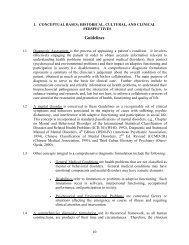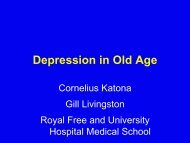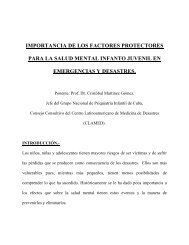ABSTRACTS - World Psychiatric Association
ABSTRACTS - World Psychiatric Association
ABSTRACTS - World Psychiatric Association
Create successful ePaper yourself
Turn your PDF publications into a flip-book with our unique Google optimized e-Paper software.
those following birth. Very little is known about the sequelae for the<br />
mother of relinquishing a child for adoption by another family. Treating<br />
women who have had abortions requires a review of the circumstances<br />
that led to the abortion, the experience of the abortion, and<br />
the reactions of friends and relatives. Women who have borne children<br />
of unwanted pregnancies may need psychotherapeutic help to<br />
resolve the feelings inherent in that situation.<br />
US9.3.<br />
GENDER DIFFERENCES IN TREATMENT SEEKING<br />
FOR MENTAL DISORDERS IN THREE COUNTRIES<br />
WITH DIFFERENT SOCIOECONOMIC STATUS<br />
M.B. Rondon<br />
Department of Psychiatry and Mental Health, Universidad<br />
Peruana Cayetano Heredia, Lima, Peru<br />
Health seeking is a complex process, the dynamics of which depend<br />
on a series of socio-demographic and socio-cultural factors. Race and<br />
gender have been found to influence help seeking behavior, in addition<br />
to social economic status and educational level. A study comparing<br />
gender sensitive mental health indicators in Canada, Colombia<br />
and Peru found that women that perceive their mental health is<br />
poor are less likely than other women to seek treatment. Men in<br />
Colombia, who have surprisingly high rates of depression and anxiety,<br />
are more prone to seek treatment than women under the same circumstances.<br />
These findings prompt us to reconsider the usual determinants<br />
of treatment seeking behavior and to give consideration to<br />
inequities determined by the submissive position of women in each of<br />
these countries. Consideration should be given to the existence of<br />
stigma towards mental illness, as well the common perceptions that<br />
there are no effective treatments for mental diseases and that available<br />
health services are of poor quality.<br />
US10.<br />
SUICIDE PREVENTION: INTEGRATION OF PUBLIC<br />
HEALTH AND CLINICAL ACTIONS<br />
US10.1.<br />
SUICIDE CAN BE PREVENTED THROUGH CLINICAL<br />
AND PUBLIC HEALTH APPROACHES<br />
D. Wasserman<br />
National Prevention of Suicide and Mental Ill-Health (NASP)<br />
at Karolinska Institute, Stockholm, Sweden<br />
Suicide prevention strategies can be directed at the general population<br />
or the health care services. For maximum overall impact, it is<br />
advisable for a public health approach to go hand in hand with a<br />
health care approach. Suicide-preventive effects of treatment with<br />
antidepressants, lithium, antipsychotics, dialectical behavioural therapy<br />
and cognitive behavioural therapy to date are encouraging. Suicide<br />
risk is high among psychiatric patients and suicide attempters,<br />
particularly after their discharge from hospital. Careful follow-up and<br />
rehabilitation plans should be provided. Adequate treatment of psychiatric<br />
disorders and improved detection of psychiatric illnesses in<br />
the general population are also essential. Successful public health<br />
preventative measures to reduce the number of suicides also include<br />
programmes which restrict access to guns, agricultural chemicals,<br />
pesticides, and raticides. Perestroika in the former USSR was history’s<br />
most effective suicide-preventive programme for men, where strict<br />
alcohol limitations were imposed and reduced consumption was<br />
actively promoted. An example of an effective strategy for combating<br />
mental illness and associated suicides in young people is the<br />
WPA/WHO initiative “Global Child Mental Health”, which aims to<br />
increase mental health awareness amongst students, teachers and<br />
other school staff, and parents, as well as to promote early diagnosis<br />
and treatment of psychiatric diseases and psychological problems. We<br />
outline how this initiative is to be used in the European Union<br />
research program SAYLE (SAving Young Lives in Europe).<br />
US10.2.<br />
THE ROLE OF HEALTH CARE WORKERS<br />
IN SUICIDE PREVENTION: FOCUS ON MOOD<br />
DISORDERS<br />
Z. Rihmer<br />
Department of Clinical and Theoretical Mental Health, Faculty<br />
of Medicine, Semmelweis University, Budapest, Hungary<br />
Suicidal behaviour is a relatively rare event in the community, but it is<br />
quite common among psychiatric patients, who contact different levels<br />
of health care services some weeks or months before the suicidal<br />
event. Over 90 percent of suicide victims have at least one current Axis<br />
I mental disorder, most frequently severe major depressive episode<br />
(56-87%), which, in the majority of cases, is unrecognized or untreated.<br />
As up to 66% of suicide victims (two-thirds of them with current<br />
depression) contact their general practitioner or psychiatrist 4 weeks<br />
before their death, health care workers play a priority role in suicide<br />
prediction and prevention. Following the pioneering Swedish Gotland<br />
Study, some large-scale community studies (like the Nuremberg<br />
Alliance Against Depression, the Swedish Jamtland Study and the<br />
recent Hungarian Kiskunhalas Suicide Prevention Study) demonstrated<br />
that education of general practitioners on the diagnosis and treatment<br />
of depression, particularly in combination with psychosocial<br />
interventions and public education, improved the correct identification<br />
and treatment of depressive disorders and reduced the frequency<br />
of suicidal behaviour in the areas served by trained practitioners. Clinical<br />
follow-up studies on severely ill formerly hospitalized patients<br />
with unipolar and bipolar major mood disorders, performed in the<br />
frame of outpatient psychiatry, also have shown that long-term pharmacotherapy<br />
with antidepressants and/or mood stabilizers markedly<br />
reduced the risk of attempted and completed suicide in this high-risk<br />
population. Although appropriate pharmacotherapy of mood disorders<br />
is essential for suicide prevention, the importance of comorbid<br />
substance-related and personality disorders as well as other psychiatric<br />
and psychosocial suicide risk factors should be also considered.<br />
US10.3.<br />
FROM THE NUREMBERG TO THE EUROPEAN<br />
ALLIANCE AGAINST DEPRESSION: PREVENTING<br />
SUICIDALITY BY COMMUNITY BASED<br />
INTERVENTIONS<br />
U. Hegerl, and the European Alliance Against Depression team<br />
Department of Psychiatry, University Hospital, Leipzig, Germany<br />
Improving the care of depressed patients, reducing access to lethal<br />
means and avoiding the Werther effect (imitation suicide) are the<br />
most promising means to reduce suicide rates. The Nuremberg<br />
Alliance against Depression has provided evidence for the effectiveness<br />
of a four-level community based intervention concept. The fourlevel<br />
intervention comprised cooperation with general practitioners,<br />
a public relations campaign, cooperation with community facilitators<br />
and local media, and support of self help activities. Careful evaluation<br />
with respect to both a baseline year and a control region revealed a<br />
significant effect concerning the number of suicidal acts (completed +<br />
14 <strong>World</strong> Psychiatry 8:S1 - February 2009

















